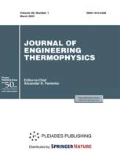Abstract
Nonstationary theory of two-velocity continuum describing the propagation of acoustic waves inmicrofractured porousmedia is based on general physical principles: the first law of thermodynamics, the conservation laws, the kinematic relationships in the metric tensor and the Galilean principle of relativity. As a physical application, the theory of the Stoneley wave in microfractured porous media is developed. The simulation results are compared with the results of physical measurement of the Stoneley wave parameters in the boreholes. It is shown that an additional fluid transport through fractures makes it possible to satisfactorily correlate the experimental and theoretical data. In general, the developed theory is a nonlinear physical model of fluid dynamics in fractured porous media.
Similar content being viewed by others
References
Dorovsky, V., Nefedkin, Yu., Fedorov, A., and Podberezhnyy, M., A Logging Method for Estimating Permeability, Velocity of Second Compressional Wave, and Electroacoustic Constant in Electrolyte-Saturated Porous Formations, Russ. Geol. Geophys., 2010, vol. 51, pp. 1247–1322.
Landau, L.D. and Lifshitz, E.M., Course of Theoretical Physics, Fluid Mechanics, Pergamon Press, 1987.
Dorovsky, V.N., Continual Theory of Filtration, Sov. Geol. Geophys., 1989, vol. 30, no. 7, pp. 39–45.
Dvorkin, J. and Nur, A., Dynamic Poroelasticity: A UnifiedModel with the Squirt and the BiotMechanisms, Geophys., 1993, vol. 58, pp. 524–533.
Parra, J.O., The Transversely Isotropic Poroelastic Wave Equation Including the Biot and the Squirt Mechanisms: Theory and Application, Geophys., 1997, vol. 62, pp. 309–318.
Diallo, M.S. and Appel, E., Acoustic Wave Propagation in Saturated Porous Media: Reformulation of the Biot/Squirt Flow Theory, J. Appl. Geophys., 2000, vol. 44, pp. 313–325.
Chen, Y.F., Yang, D.H., and Zhang, H.Z., Biot/Squirt Model in Viscoelastic Porous Media, Chin. Phys. Lett., 2002, vol. 19, pp. 445–448.
Yang, D. and Zhang, Z., Poroelastic Wave Equation Including the Biot/Squirt Mechanism and the Solid/Fluid Coupling Anisotropy, Wave Motion, 2002, vol. 35, pp. 223–245.
Adelinet, M., Fortin, J., and Gueguen, Y., Dispersion of ElasticModuli in a Porous-Cracked Rock: Theoretical Predictions for Squirt-Flow, Tectonophys., 2011, vol. 503, nos. 1/2, pp. 173–181.
Tang, X.M., A Unified Theory for ElasticWave Propagation through PorousMedia Containing Cracks—An Extension of Biot’s PoroelasticWave Theory, Science China Earth Sci., 2011, vol. 54, no. 9, pp. 1441–1452.
Tang, X.-M., Chen, X.-L., and Xu, X.-K., A Cracked Porous Medium Elastic Wave Theory and Its Application to Interpreting Acoustic Data from Tight Formations, Geophys., 2012, vol. 77, no. 6, pp. D245–D252.
Mavko, G. and Nur, A., Melt Squirt in the Asthenosphere, J. Geophys. Res., 1975, vol. 80, pp. 1444–1448.
Mavko, G. and Nur, A., Wave Attenuation in Partially Saturated Rocks, Geophys., 1979, vol. 44, pp. 161–178.
Thomsen, L., Biot-Consistent Elastic Moduli of Porous Rocks: Low-Frequency Limit, Geophys., 1985, vol. 50, pp. 2797–2807.
Tuncay, K. and Corapcioglu, M.Y., Wave Propagation in Fractured Porous Media, Transport in Porous Media, 1996, vol. 23, no. 3, pp. 237–258.
Pride, S.R. and Berryman, J.G., Linear Dynamics of Double Porosity Dual-Permeability Materials, I, II, Phys. Rev. E, 2003, vol. 68, ID 036603, 036604.
Cui, Z.W. and Wang, K.X., Influence of the Squirt Flow on Reflection and Refraction of Elastic Waves at a Fluid/Fluid–Saturated Poroelastic Solid Interface, Int. J. Eng. Sci., 2003, vol. 41, pp. 2179–2191.
Cui, Z.W., Liu, J.-X., and Wang, K.X., Influence of Squirt Flow on Guided Waves in a Borehole, J. Jilin Univ., 2005, vol. 43, no. 6, pp. 803–808.
Wu, X. and Yin, H., Method for Determining Reservoir Permeability Form Borehole Stoneley Wave Attenuation Using Biot’s Poroelastic Theory, USPatent, 7830744 B2, 2010.
Dorovsky, V., Dubinsky, V., Fedorov, A., Podberezhnyy, M., Nefedkin, Yu., and Perepechko, Yu., Method and Apparatus for Estimating Formation Permeability and Electroacoustic Constant of an Electrolyte-Saturated Multi-Layered Rock Taking into Account Osmosis, Patent Appl. Publ., US 2010/0254218 A1, 2010.
Winkler, K.W., Liu, H.L., and Johnson, D.J., Permeability and Borehole Stoneley Waves: Comparison between Experiment and Theory, Geophys., 1989, vol. 54, pp. 66–75.
Dorovsky, V., Perepechko, Yu., and Fedorov, A., The Stoneley Waves in the Biot–Johnson Theory and Continual Filtration Theory, Russ. Geol. Geophys., 2012, vol. 53, pp. 621–630.
Dorovsky, V., Perepechko, Yu., and Fedorov, A., Stoneley Wave Electroacoustic Ratio, Electric Field in Presence of Radial Borehole Waves, and Related Method of Measuring Permeability and Electroacoustic Constant, Russ. Geol. Geophys., 2013, vol. 54, pp. 621–630.
Zoback, M.D., Reservoir Geomechanics, Stanford University, 2010.
Godunov, S.K. and Romenskii, E.I., Elements of ContinuumMechanics and Conservation Laws, Kluwer, 2003.
Dorovsky, V.N. and Perepechko, Yu.V., Phenomenological Description of Two-Velocity Media with Relaxing Shear Stresses, J. Appl. Mech. Tech. Phys., 1992, vol. 33, no. 3, pp. 403–409.
Dorovsky, V.N., Mathematical Models of Two-Velocity Media, Math. Comput. Model., 1995, vol. 21, no. 7, pp. 17–28.
Dorovsky, V.N. and Perepechko, Yu.V., Mathematical Models of Two-Velocity Media, Part II: Math. Comput. Model., 1996, vol. 24, no. 10, pp. 69–80.
Blohin, A.M. and Dorovsky, V.N., Mathematical Modeling in the Theory of Multivelocity Continuum, Nova Sci. Publ., 1995.
Dorovsky, S., An Approach to Automated Development of HydrodynamicModels, Progr. Syst., 2011, vol. 4, pp. 123–129.
Tisza, L., Sur la supraconductibilitéThermique de l’hélium IIliquide et la Statistique de Bose–Einstein, Comptes Rendus Ac. Sci. (Paris), 1938, vol. 207, pp. 1035–1037.
Tisza, L., La viscositéde l’hélium II liquide et la Statistique de Bose–Einstein, Comptes Rendus Ac. Sci. (Paris), 1938, vol. 207, pp. 1186–1189.
Author information
Authors and Affiliations
Corresponding author
Rights and permissions
About this article
Cite this article
Dorovsky, V., Perepechko, Y., Romenski, E. et al. Thermodynamic compatible model of microfractured porous media and Stoneley waves. J. Engin. Thermophys. 25, 182–196 (2016). https://doi.org/10.1134/S1810232816020041
Received:
Published:
Issue Date:
DOI: https://doi.org/10.1134/S1810232816020041




